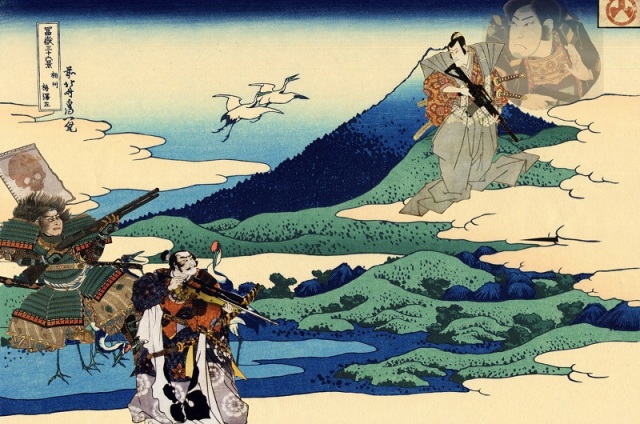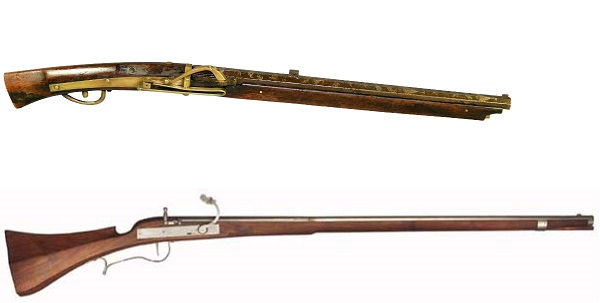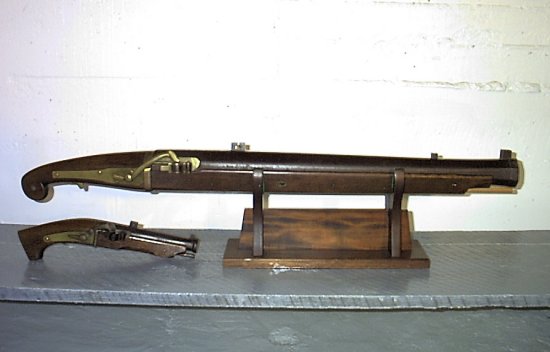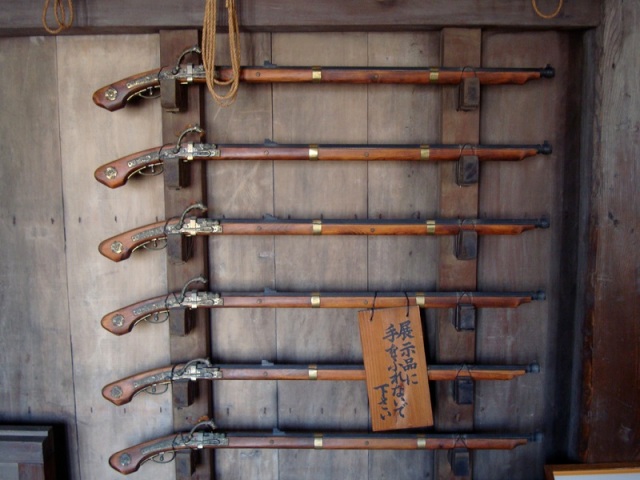
When people think about historical Japan, samurai and their swords come immediately to mind. Perhaps we have images of masterless ronin wandering the lands and getting into thrilling adventures, or maybe we envision the noble families and their loyal retainers. Those with an eye on society might also be thinking about how people lived and worked, and what that meant for everyone (some of the effects are not obvious). But there’s something that is almost always missing from whatever picture we create – guns. In this article I’ll be looking at what firearms they had, how they were used… and why they weren’t.
The common idea seems to be that Japanese society deliberately turned away from gunpowder weapons until they were forced to accept the rest of the world in general, in 1868 with the Meiji Restoration. The Last Samurai is still a decent movie, and that image of a doomed samurai charge towards soldiers with firearms is a powerful one (the locations have exactly the right look too, incidentally – I visited one of them). But, in a development that will surprise absolutely no-one, it isn’t entirely accurate in all respects.
The fact of the matter is that Edo-period Japan did know about guns. The Japanese term for them was tanegashima, after the island where Portuguese traders introduced them in 1543, and they played an important role during the Warring States period. By the end of that time there were quite a lot of them, and military architecture often took that into account. Next time you visit an original Japanese castle, look for little triangular or round holes in the walls: they’re intended for guns to be fired out of (although you might have to look for them from the inside, because they were often covered outside with a thin layer of plaster to conceal them). However, the fact remains that after the Sengoku-era guns weren’t used very much. Because of that, they didn’t go through the same fast-paced (and occasionally bizarre) evolution that firearms in other parts of the world did. We’ll come back to this later.

Above is a tanegashima, below is a Dutch matchlock. Both are from around 1600 AD. Note how the Dutch weapon has a more fully-developed stock, improving accuracy.
The most common design was a long gun like those in the picture above. They were short by Western standards, but still more than 130cm long with a 100cm barrel length. Ashigaru (foot soldiers) would carry them in place of spears and fire them in volleys. Firing from behind cover such as a low walls, they could effectively stop an infantry or cavalry charge.
A longer version, 150cm or even more, was intended for use from castle walls or ships. These were known as hazamatutu. A slightly shorter version, the bajoututu, were intended for use from horseback. They filled the same role as cavalry carbines in the West. Pistols (tantutu) were not regarded as reasonable weapons, and in fairness I can see why. Matchlock pistols are so big and heavy that most of the time you’re better off with a long gun that has an effective range greater than arm’s length. And sticking a length of burning slowmatch in your pocket is hardly practical.
There were larger weapons also in use, with calibers starting at 15mm and going all the way up to nearly 30mm, but the largest in “common” use were fifty-monme monsters with a bore of nearly 90mm. These were used in the same way as light cannon, against ships or fortifications. The Japanese had very little in the way of heavier cannons or siege artillery. Partly this was because they generally didn’t need it; keep in mind the different context Japanese castles existed in. But given the hilly nature of Japan, criss-crossed as it was with streams, lugging heavy weapons around the countryside can’t have been a very appealing prospect.

One of the fifty monme guns, next to a tanegashima pistol. Neither would have been much fun to carry long distances.
For 50 or 60 years after their introduction, the Japanese became quite enthusiastic about guns. A good deal of effort and ingenuity was lavished on overcoming their disadvantages, such as lacquerware boxes to ensure the firing mechanism stayed dry, and tactics for using them in battle were developed also. A great many firearms were built. By the time of the Japanese invasion of Korea in 1592, guns were seen as an important arm of Japanese forces and nearly 40,000 of the invasion force was armed with them.
And then… they stopped. From shortly after 1600 until Commodore Perry arrived in Japan in 1854, firearms stopped being a major feature of the Japanese military landscape. Everyone still had them, and there were still plenty of people who could make them. But for 250 years, the guns mostly stayed in their racks.

There wasn’t some kind of Imperial decree or religious prohibition against them, or even a feeling that they were contrary to honour. No, the reason for this is actually boringly prosaic: they just didn’t need them. The main advantage of firearms in the Edo period was that a peasant or low-ranking soldier could become an adequate gunner quite quickly – certainly quicker than turning them into an adequate archer or spearman. But once the Tokugawa Shogunate was firmly in control, the need for large armies of quickly-trained soldiers vanished. And with that out of the way, the disadvantages of the matchlock became much more important.
For one thing, they didn’t work well in rainy or humid conditions. If the powder or match gets damp, it won’t burn properly and the gun turns into an expensive and ill-balanced club. As anyone who has lived in Japan can tell you, rainy or humid conditions are quite common during large parts of the year.
Tanegashima also didn’t compare well with the abilities of a trained archer. Samurai were in the main very skilled with these weapons (historically, the main tools of the samurai had been the horse and bow). And the difference in capabilities was immense – a samurai archer could strike targets much further away and much more accurately than any matchlock firearm was capable of. They could do it more often, too – one Japanese test at the time indicated a decent archer could loose 15 arrows in the time it took a gunner to load and fire once.

Given the small scale of the conflicts that arose during the Edo period and the high level of training that could be given to the main combatants, the sword and bow were simply more practical weapons for the setting. That meant the guns mostly stayed in the storehouses, or were used by hunters and farmers. There wasn’t the same relentless Darwinian pressure driving their development as there was elsewhere, so firearms design plateaued.
As an aside, it’s also not obvious what options there were for development. In the West, matchlocks were replaced by wheel-lock and flintlock designs. However, wheel-locks are complex to make and difficult to maintain; hardly suitable for widespread adoption. And flint is a product of sedimentary rocks such as chalk. These do not naturally occur in Japan, which is of volcanic origin. Once the country was opened to trade with the rest of the world in 1854 Japanese gunsmiths rapidly converted tanegashima into flintlock and percussion cap weapons, but it is an open question what they might have come up with on their own if there had been the impetus to do so.

This is a section of an original woodprint showing samurai using tanegashima. Compare their posture with the smartgun operators from Aliens…
So there’s a short look at the guns of the samurai. Shogunate-era Japan certainly knew about firearms, and was entirely willing to use them when it seemed necessary. But most of the time, they just weren’t the best tool for the job. It’s as simple as that.
Question of the post: Having looked at money, castles, and now weapons, are there any other aspects of Shogunate Japan that people are interested in seeing an article about? Or are there other parts of history and/or military issues that would benefit from an article like this?
Always a joy reading you well-researched, well-reasoned, and well seasoned (with humour) posts, my good sir.
As to your question – what niggles for me is the issue of social status and how ‘knowing one’s place’ would have been essential to a stable feudal society. What were the layers, how were they enforced, and were they ever subverted/defied/overcome?
Why I ask is that I recently caught up with “Princess Kaguya” the movie, which did a lot to depict (and gently mock) the social strata of Japan. (Although it might not have been precisely set in the Shogunate era. I’m no expert in recognising all the details.)
LikeLike
Hmm, interesting question. Some of the layers are fairly obvious, but their enforcement and challenges to them aren’t so much. I’ll see what I can find out.
LikeLike
Interesting topic. I always thought that the nobility didn’t want guns to develop since, as you pointed out, they did not require the discipline and training that a bowman or swordsman did thus reducing the possibilities of revolutions. I’m curious about how often they appear in the classic Japanese cinema. They only ones that I know of that used guns were “The Seven Samurai” and “Seppuku” though my experience doesn’t include those such as “Ran” and “The Hidden Fortress”.
I wonder what the quality of the gunpowder hand weapons during the period where they were most popular compare with the weapons of WWII. I’ve never heard anything good about the nambu pistol for example.
One post I would suggest would be other types of weapons of the era such as the bows you mention armor and pole weapons. Another would be tactics of the era and how efficient or innovative the generals tended to be in that regard.
LikeLike
I’m sure there was a component of that – Edo-period Japan might not have been a hotbed of revolutionary fervour, but those with power would not have been at all thrilled by the notion of military success being easy to come by for those concerned.
The Nambu pistol doesn’t have a good reputation, no, and the standard LMG also seems to have been underwhelming. It’s interesting that modern thoughts on small-arms cartridges are coming back towards the 6.5mm or 6.8mm rounds – the Arisaka rifle used a 6.5mm which seems almost prescient.
Thanks for the post ideas, I’ll add them to my list!
LikeLike